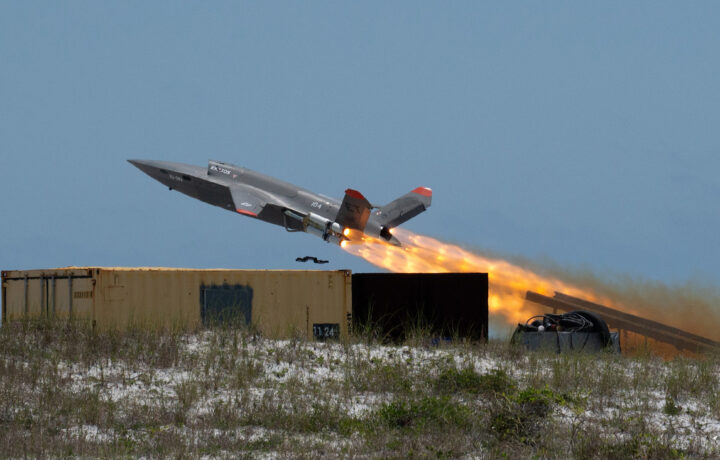Last November, technology entrepreneur Elon Musk made headlines when he suggested in a post on X (the social media platform formerly known as Twitter) that only “idiots” were still making manned fighters rather than focusing on drones. However, as aviation experts weighed in at the time, both manned and unmanned aircraft are likely to be the future.
The United States Air Force has continued to forge ahead with its sixth-generation manned fighter, with Boeing contracted to build the F-47. It is the centerpiece “system of systems” that is part of the Next-Generation Air Dominance (NGAD) program, while the air service is also investing heavily in the Collaborative Combat Aircraft (CCA). This unmanned aircraft will support future manned fighters.
However, the Air Force also announced that it had demonstrated “a major leap in human-machine teaming.” It saw autonomous collaborative platforms operating alongside crewed fighters during a recent training event at Elgin Air Force Base (AFB), FL.
“Pilots operating an F-16C Fighting Falcon and an F-15E Strike Eagle each controlled two XQ-58A Valkyrie aircraft in an air combat training scenario, showcasing real-time integration between manned and semi-autonomous systems,” the Air Force explained.
Ride of the Valkyries
The XG-68A Valkyrie is an experimental stealthy unmanned combat aerial vehicle (UCAV) designed and built by Kratos Defense & Security Solutions as part of the Low-Cost Attritable Strike Demonstrator (LCASD) program. It is a different effort than the aforementioned CCA.
Autonomous Collaborative Platforms are seen as a “key enabler of future airpower,” by providing affordable, runway-flexible capabilities that can operate semi-autonomously in high-risk environments. The Air Force recognizes that ACPs can serve as force multipliers, particularly in contested environments, while allowing operators to maintain strategic and ethical oversight.
This recent test flight was viewed as a pivotal step in integrating ACPs into air combat. It offers key benefits, including reducing pilot workload while enhancing situational awareness and mission effectiveness. As the Air Force modernizes to meet the demands of a more contested and complex operating environment, it sees a greater need for human-machine teaming, where ACPs could be vital to delivering credible mass, operational flexibility, and mission success.
“This test with ACPs directly addresses the evolving requirements of modern warfare and the needs articulated by our warfighters,” explained Gen. Ken Wilsbach, commander of Air Combat Command. “We are committed to innovation and integrating ACPs through these kinds of demanding, operator-driven evaluations that allow us to learn rapidly and enhance our human-machine teams. This approach is fundamental to sharpening our combat capabilities, maintaining air superiority and ensuring we can effectively support the joint force in complex future environments.”
The recent test flight was supported by the Department of Defense’s (DoD’s) Rapid Defense Experimentation Reserve program under the Office of the Under Secretary of Defense for Research and Engineering, and executed by Air Force Materiel Command’s Air Force Research Laboratory and Air Force Test Center, Air Combat Command and U.S. Navy. It demonstrates a joint approach to capability development that is responsive to operational needs.
“With this flight, we mark a crucial step in developing capabilities that harness human-machine teaming to overcome complex threats and expand our advantages,” added Brig. Gen. Jason E. Bartolomei, commander of the Air Force Research Laboratory. “By developing and integrating autonomous platforms with manned systems, we can quickly adapt, increase combat effectiveness and reduce risk to our aircrews in contested environments.”
The service reported that data from the recent flight demonstration will be used to “inform future development and deployment of semi-autonomous capabilities” across the DoD.
The ACP and CCAs could each fill different roles, but serve in similar capacities as the “loyal wingman,” where the unmanned aircraft can be force multipliers for manned fighters. This is especially attractive to the U.S. Air Force, as the service has built fewer and fewer, yet increasingly expensive, aircraft in recent decades, such as the Lockheed Martin F-35 Lightning II, which costs $80 million per unit. The future Boeing F-47 could be even more costly, yet it would be produced in significantly smaller numbers.
That has left the service with a significantly smaller fleet, not to mention many older aircraft, such as the B-52 bombers, which are older than the parents (and in many cases, the grandparents) of the current generation of aircrews.
A flight of Valkyrie drones could be just what the Air Force needs. Cue the Wagner soundtrack!




